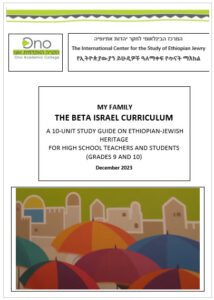MY FAMILY
THE BETA ISRAEL CURRICULUM

BETA ISRAEL OR FALASHA?
At this stage, teachers must explain that there are often two terms used to describe the Ethiopian Jewish community which may appear to some to be interchangeable but in fact have very different connotations. The first term is the Beta Israel, as introduced above. The second term is the Falasha.
Students should be given a piece of paper containing both terms –
Beta Israel and Falasha. The students should then be asked to produce a conceptual map of associations: what comes to mind when they hear each of these terms? Their answers will likely depend on how the teacher explained each of these terms.
Teachers should then explain:
It is important to note that while many people, books, and articles, refer to the Ethiopian Jewish community using the term Falasha,13 it should not be considered interchangeable with Beta Israel. The word Falasha literally means “exiled,”14 and while that term is technically true – at some points in history, even the Beta Israel called themselves Falasha – over time, it has taken on a derogatory tone.15
Given this distinction, members of the tribe traditionally prefer to call themselves the Beta Israel,16 meaning the House of Israel. This term affirms the community’s origins from the Land of Israel and the Tribes of Israel.17 It also symbolically proclaims that the Beta Israel always remained loyal to its Jewish faith, and refused to abandon its origins, or convert to Christianity, despite pressure and persecution.
After this context is explored, students should be asked:
Based on our discussion, why do you think this curriculum deliberately uses the term Beta Israel and not the term Falasha to teach about the Jews of Ethiopia?
This question should prompt a discussion about the importance of “subjective identity” and “self-identification” as opposed to “assigned identification” – i.e., the notion that individuals and groups should be free to choose their own names and identities, and not be forced to accept labels ascribed by outsiders.18
In addition, students should be reminded that this curriculum – unlike most books and studies about Ethiopian Jewry – was written with a particular sensitivity (an “insider” perspective) that reflects how the Beta Israel community sees itself, and deliberately avoids the use of pejorative labels given by others, both in the past and in the present.
12 Teachers should acknowledge that some of these theories suggest that the Beta Israel may not originally be Although that conclusion is firmly rejected within this curriculum, the sentiment has unfortunately been expressed by some researchers – and even rabbis – to a sufficient extent leading to questioning of the Beta Israel’s Jewish status.
13 It should be noted that the word “Falasi” was first used in a decree of Emperor Yeshaq (1413-1430), who ruled that while a person baptized to Christianity could inherit land from his father, the “Falasi” could not inherit By the sixteenth century, the term “Falasha” entered popular usage in Ethiopian, Arabic, and Hebrew sources. In general, the term ‘Falasha’ was understood to mean “exiles and migrants.” See Michael Corinaldi, Jewish Identity: The Case of Ethiopian Jewry, (Magnes Press, 1998), pp. 55-56.
14 Rabbi Sharon Shalom, From Sinai to Ethiopia, (Gefen Publishing House, 2016), p. 32.
15 Corinaldi, Jewish Identity: The Case of Ethiopian Jewry, 56-57.
16 Shalom, From Sinai to Ethiopia, 32.
17 Corinaldi, Jewish Identity: The Case of Ethiopian Jewry, 54.







